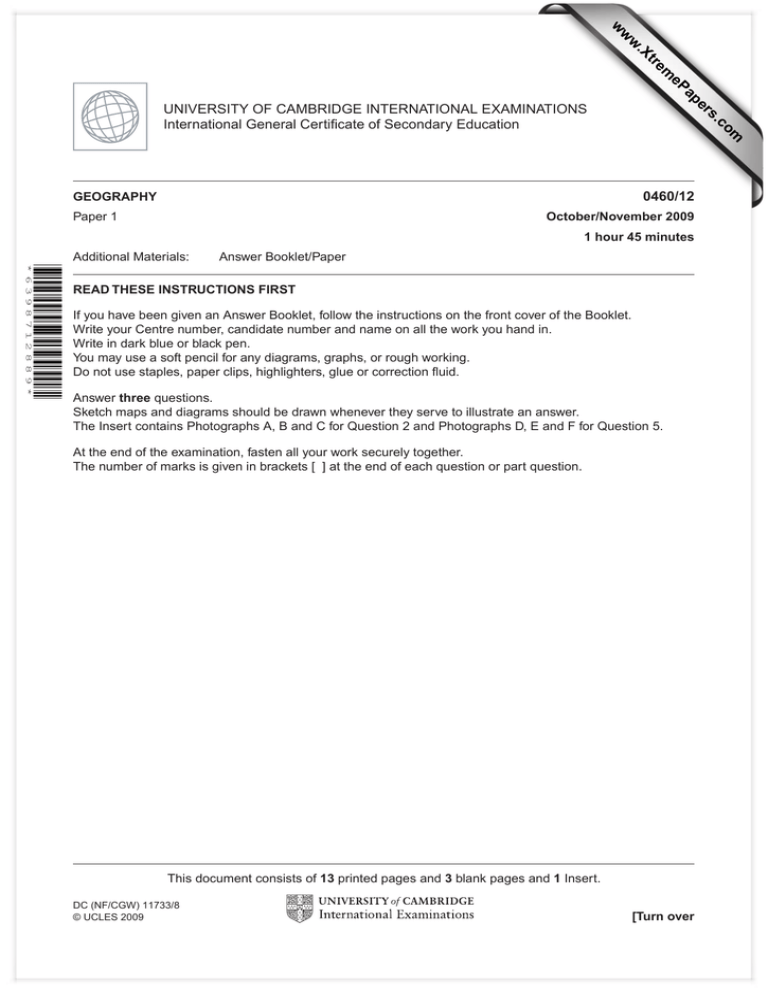www.XtremePapers.com
advertisement

w w ap eP m e tr .X w om .c s er UNIVERSITY OF CAMBRIDGE INTERNATIONAL EXAMINATIONS International General Certificate of Secondary Education 0460/12 GEOGRAPHY Paper 1 October/November 2009 1 hour 45 minutes Additional Materials: Answer Booklet/Paper *6398712889* READ THESE INSTRUCTIONS FIRST If you have been given an Answer Booklet, follow the instructions on the front cover of the Booklet. Write your Centre number, candidate number and name on all the work you hand in. Write in dark blue or black pen. You may use a soft pencil for any diagrams, graphs, or rough working. Do not use staples, paper clips, highlighters, glue or correction fluid. Answer three questions. Sketch maps and diagrams should be drawn whenever they serve to illustrate an answer. The Insert contains Photographs A, B and C for Question 2 and Photographs D, E and F for Question 5. At the end of the examination, fasten all your work securely together. The number of marks is given in brackets [ ] at the end of each question or part question. This document consists of 13 printed pages and 3 blank pages and 1 Insert. DC (NF/CGW) 11733/8 © UCLES 2009 [Turn over 2 1. (a) Study Fig. 1, which shows information about birth rates and death rates for the world and different continents in 2007. Key 40 35 births 30 deaths 25 births and deaths per 1000 20 15 10 5 0 World Africa Asia Europe North Oceania South America America Source: http://images.encarta.msn.com/xrefmedia/aencmed/targets/illus/cha/T045961A.gif Fig. 1 (i) What is meant by birth rate? [1] (ii) Calculate the natural population growth rate of the world in 2007. You must show your calculations. [2] (iii) (iv) © UCLES 2009 Name a continent where in 2007: A birth rates were higher than the world average, B death rates were lower than the world average, C natural population decrease occurred. Suggest reasons why birth rates in Europe and North America are low. 0460/12/O/N/09 [3] [4] 3 (b) Study Fig. 2, which shows an extract from a website. Europe’s ageing population Europe’s rate of population growth is falling while the inhabitants are ageing. Who will solve the problems which this is causing? Some people believe that immigration could be the solution to Europe’s problems. Source: http://news.bbc.co.uk/1/hi/world/europe/2053581.stm (much amended) Fig. 2 (i) Describe three problems which are caused by an ageing population [3] (ii) Many international migrants have moved from LEDCs to MEDCs in Europe. Explain how an MEDC might benefit from receiving these international migrants. [5] (c) For a country or area which you have studied, describe and explain variations in the population density. [7] © UCLES 2009 0460/12/O/N/09 [Turn over 4 2 (a) Study Fig. 3, which shows three different rural settlement patterns. N 60 Area X 90 60 N Area Y 120 90 60 30 N Area Z 30 60 Key road 0 1 km buildings 60 contour (metres) river Fig. 3 © UCLES 2009 0460/12/O/N/09 5 (i) Area X shows dispersed settlement. What is meant by dispersed settlement? [1] (ii) Suggest two reasons why a linear settlement pattern has developed at Y. [2] (iii) Name the type of settlement pattern at Z and suggest two reasons for the growth of a settlement at this site. [3] (iv) Explain why many people in LEDCs are migrating away from rural areas. [4] (b) Study Photographs A, B and C (Insert), which show three urban areas in an MEDC. (i) For each of the three areas in Photographs A, B and C, identify the main land use. (ii) Choose one of the three areas shown in Photographs A, B or C. Write down the letter of the photograph you have chosen and suggest reasons why that land use developed there. [5] (c) For a named urban area, describe the impacts of its growth on the environment. [3] [7] [Total: 25 marks] © UCLES 2009 0460/12/O/N/09 [Turn over 6 3 (a) Study Table 1, which suggests what the impacts of five different natural hazards might be. Table 1 Type of hazard Predictability Size of area affected Short-term impact Long-term impact Drought Predictable 4 2 4 Earthquake Unpredictable 1 3 3 Flood Predictable 2 4 3 Tropical storm Very predictable 3 3 2 Volcanic eruption Quite predictable 1 3 2 Each potential impact is graded on a scale of 1 (smallest) to 4 (largest) (i) What is meant by a natural hazard? (ii) Give an example from Table 1 of a natural hazard caused by: A tectonic activity; B weather/climate. [1] [2] (iii) Using only the evidence from Table 1, compare the effects of droughts and earthquakes. [3] (iv) Suggest reasons why the impacts of natural hazards are usually greater in LEDCs than in MEDCs. [4] © UCLES 2009 0460/12/O/N/09 7 (b) Study Fig. 4, a map showing earthquake activity along a plate boundary. Eurasian Plate Iranian Plate Indo-Australian Plate Arabian Sea Indian Ocean 0 Key 1000 plate boundary earthquake km Fig. 4 (i) Explain why earthquakes occur close to plate boundaries, such as those shown in Fig. 4. [3] (ii) Explain why people still live in areas which are at risk from earthquakes. [5] (c) For a named example of an earthquake which you have studied, describe its short-term and long-term impacts. [7] [Total: 25 marks] © UCLES 2009 0460/12/O/N/09 [Turn over 8 4. (a) Study Fig. 5, which shows data that a student has collected about the weather. Maximum temperature Minimum temperature Precipitation Wind Speed Wind direction Relative humidity Atmospheric pressure Cloud cover Monday 21st 19 ˚C 11 ˚C 5mm 4km/hr SW 80 998mb 6 oktas Tuesday 22nd 17 ˚C 12 ˚C 0 7km/hr SE 72 1008mb 2 oktas Wednesday 23rd 20 ˚C 13 ˚C 2mm 3km/hr SW 84 1002mb 7 oktas Day Table 2 (i) Which day had the largest daily (diurnal) range of temperature? [1] (ii) Explain how cloud cover is estimated and shown on a map. [2] (iii) Name the weather instrument used to measure: (iv) A relative humidity; B wind speed; C atmospheric pressure. [3] Explain how the student used a maximum - minimum thermometer (Six’s thermometer) to measure the temperatures shown in Fig. 5. You may include a diagram to show how this weather instrument is read and reset after use. [4] © UCLES 2009 0460/12/O/N/09 9 (b) Study Fig. 5, which shows different cloud types. cirrostatus High level Middle level Low level cirrocumulus cirrus cumulonimbus altostratus altocumulus nimbostratus stratus cumulus stratocumulus Source: http://www.ilmutrans-udara.com/?p=64 Fig.5 (i) Describe three differences between nimbostratus and altocumulus clouds. [3] (ii) Explain how cumulonimbus clouds form and bring heavy rain in areas of tropical rain forest. [5] (c) Describe and explain the impacts of human activities on the natural environment of a named area of tropical rain forest which you have studied. [7] [Total: 25 marks] © UCLES 2009 0460/12/O/N/09 [Turn over 10 5 (a) Study Fig. 6, which shows information about the percentage of Canada’s electricity generated in each province. Yukon and North West Territories British Columbia Alberta Newfoundland Manitoba Saskatchewan Ontario Québec Key international boundary provincial boundary Scale for bars: 2 mm = 1% of Canada’s electricity Fig. 6 (i) © UCLES 2009 In which province is most electricity generated? 0460/12/O/N/09 [1] 11 (ii) Study Table 2, which shows the percentages of the electricity generated in each Canadian province, by source. Table 3 Coal (%) HEP (%) Natural gas (%) Nuclear (%) Others (%) 48 8 42 0 2 British Columbia 0 88 7 0 5 Manitoba 2 91 7 0 0 Newfoundland 2 87 0 0 11 Ontario 19 22 7 51 1 Québec 0 97 0 2 1 48 25 22 0 5 0 99 0 0 1 Province Alberta Saskatchewan Yukon and North West Territories Use evidence from Table 2 to name a province where: A most electricity is generated from fossil fuels; B the main method of electricity generation is nuclear power. [2] (iii) Compare the importance of different methods of electricity generation in Québec and Ontario. [3] (iv) Explain why the importance of hydro-electric power (HEP) varies between different areas. [4] (b) Study Photographs D, E and F (Insert), which show three methods of generating renewable energy. (i) What type of energy is being generated in each of Photographs D, E and F? [3] (ii) Explain the increasing importance of renewable energy sources, such as those shown in the photographs, in many countries. [5] (c) Name an area or a country which you have studied where large amounts of fuelwood are used for energy. Describe the problems this causes for local people and the natural environment. [7] [Total: 25 marks] © UCLES 2009 0460/12/O/N/09 [Turn over 12 6. (a) Study Fig. 7, which shows the employment structure of five countries. 100 0 10 90 20 80 se co nd ary in plo ye d 60 40 r cto se em 50 50 ry tia er nt 40 60 di ye plo em se cto r % 30 70 % Bulgaria 70 USA 30 Brazil China 80 20 Bangladesh 90 10 0 100 90 80 70 60 50 40 30 20 10 100 0 % employed in primary sector Fig. 7 (i) What percentage of the population of China is employed in the secondary sector? [1] (ii) Name the country which has: (iii) © UCLES 2009 A equal percentage secondary sectors; of the population employed B 75% of the population employed in the tertiary sector. in the primary and [2] Explain why a large percentage of the population is employed in the primary sector in LEDCs such as Bangladesh. [3] 0460/12/O/N/09 13 (b) Study Fig. 8, which shows how cement is made. fuel gypsum Limestone clinker is Clinker roasted in Clay kilns 1900°C Cement clinker is crushed to powder Fig. 8 (i) Using Fig. 8, identify: A a raw material; B a process; C an output. [3] (ii) A cement factory was opened in 2007 at Buipe (a town in Ghana.) Suggest how the cement factory may benefit local people. [4] (iii) Describe the problems which manufacturing industries, such as the cement factory, might cause for the natural environment in and around Buipe. [5] (c) Name an area where high technology industry has been located and explain the factors which attracted this type of industry to the area. [7] [Total: 25 marks] © UCLES 2009 0460/12/O/N/09 14 BLANK PAGE 0460/12/O/N/09 15 BLANK PAGE 0460/12/O/N/09 16 BLANK PAGE Copyright Acknowledgements: Question 1 Question 2 Question 5 Question 5 Question 6 Fig. 2 Photographs A, B and C Photograph D Photographs E and F Fig. 8 © Oman Daily Observer S. Sibley, © UCLES © www.rainorshinepower.com S. Sibley, © UCLES © World Resources Institute, www.images.wri.org/map_cartogram_global_warming-large.gif Permission to reproduce items where third-party owned material protected by copyright is included has been sought and cleared where possible. Every reasonable effort has been made by the publisher (UCLES) to trace copyright holders, but if any items requiring clearance have unwittingly been included, the publisher will be pleased to make amends at the earliest possible opportunity. University of Cambridge International Examinations is part of the Cambridge Assessment Group. Cambridge Assessment is the brand name of University of Cambridge Local Examinations Syndicate (UCLES), which is itself a department of the University of Cambridge. 0460/12/O/N/09








